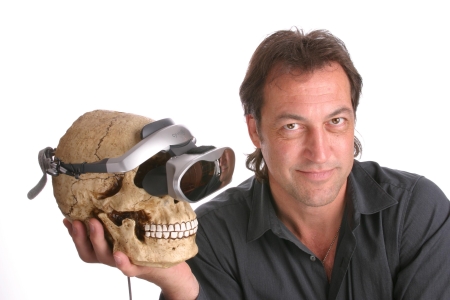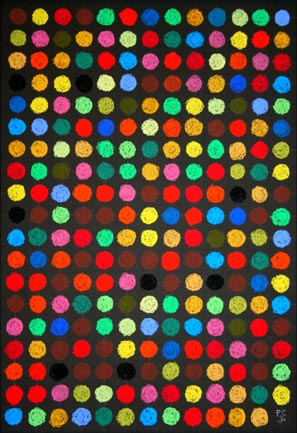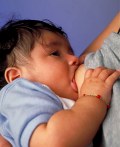The DNA Network |
| In rheumatoid arthritis, kicking the habit brings relief [The Navigator - Navigenics Blog] Posted: 24 Nov 2008 08:28 PM CST Michael Nierenberg, M.D.
For years, scientists have known that smoking increases a person’s risk for developing this inflammatory condition, which causes pain, swelling and stiffness in the joints. Studies also indicated that tobacco smoke increases the severity of the disease in those who have it. Now comes the first solid evidence that kicking the habit may actually help arthritis sufferers control their disease. Rheumatoid arthritis patients who stop smoking "may see an improvement in the number of joints that hurt them every day and in how they feel overall," said Dr. Mark C. Fisher, leader of the new study in a written statement. The results were presented recently at the Rheumatology Annual Scientific Meeting in San Francisco. |
| Medicine Meets Virtual Reality 17: Interviews and a blog [ScienceRoll] Posted: 24 Nov 2008 04:10 PM CST I’m honored to be in the organizing committee for next year’s Medicine Meets Virtual Reality conference that will take place in Long Beach, CA between 19 and 22 of January, 2009. Now I write a blog for the conference and publish a series of interviews with famous participants. The first interviewee is Dr. Albert “Skip” Rizzo and the topic is virtual reality therapy. Check it out!  |
| What are your favorite iPhone apps? [Discovering Biology in a Digital World] Posted: 24 Nov 2008 01:10 PM CST Now that I've downloaded really important applications like a timer for cooking, a program for playing with molecular structures, and an app that lets me listen to NPR on my phone, I'm ready for more. I'm seriously overwhelmed by the iTunes App store. I found a program for learning human anatomy, a laboratory calculator for making solutions, music programs, wow! Who knew? I know some schools are using iPhones for teaching, but I never realized how much was out there. Deepak recommends something called TouchPhysics. What are you using? What cool apps do you suggest? Technorati Tags: iphone Read the comments on this post... |
| Finding the Off Switch in Leukemia Cells [adaptivecomplexity's blog] Posted: 24 Nov 2008 12:09 PM CST Cancer cells of all types have one thing in common: they have escaped the built-in controls of cell reproduction, and as a result, tumors grow as the out-of-control cells keep dividing. This out-of-control cell division in cancer is very closely connected to a process called differentiation, the process by which a cell stops dividing and transforms itself from a stem cell into a specialized cell like a red blood cell. There is a trade-off: differentiated cells are specialized and tend to not divide; undifferentiated cells tend to divide but don't carry out specialized functions. The problem with cancer cells is that they are more like undifferentiated, dividing stem cells than the non-dividing, differentiated cells we want them to be. |
| Slideshow: Health and Medical Eduation in Second Life [ScienceRoll] Posted: 24 Nov 2008 10:59 AM CST Guus van den Brekel published a slideshow about the medical educational opportunities Second Life provides: Further reading:  |
| Tid Bits - Classics Edition [The Daily Transcript] Posted: 24 Nov 2008 10:54 AM CST I love the classics - be it Greek plays, Roman history, all of the great myths or all of the ancient philosophers that lie at the base of our western civilization. (Weren't those Atomists so prescient?) And yes, I also managed to marry a classics major. That's why I thank the FSM that I live in an age where you can obtain all this information for free and downloadable onto your iPod. So what's out there? Well a few months back I was in despair (along with hundreds of others) about the apparent downfall of the History of Rome Podcast. Well over the weekend Mike Duncan, just like Cincinnatus, came back from retirement and came out with a brand new episode on the great general Sulla (Pompey, Crassus and young Julius Caesar have even made an appearance). I strongly advise you to subscribe to this podcast, it's probably the best solo web production out there. I also advise you to start from the beginning where Mike summarizes the Aeneid and the Romulus and Remus myth. From there you'll need to listen to about 40 shows to be up to date (although we are on episode #34, some previous shows were split into sections "a", "b" and "c"). And the revival came just in time, as my wife and I have been plowing through HBO's miniseries Rome, a reenactment of the rise and fall of Caesar finishing with the crowning of Augustus. Speaking of classics, I've also noticed that an audio version of Thucydides' The History of the Peloponnesian War and Herodotus' Histories Vol. 1 have recently been made available for free from Librivox.org. (Other great works you can download from Librivox include The Iliad and The Odyssey.) Read the comments on this post... |
| $1500 MicroArray Challenge [ScienceRoll] Posted: 24 Nov 2008 08:19 AM CST I’ve come across the $1500 MicroArray Challenge on Medgadget.
I tried to use the colours as nucleotides and then place the codes of the possible amino acids in order, but no result…  |
| Medicine 2.0 Blog Carnival: Edition 35 [ScienceRoll] Posted: 24 Nov 2008 08:10 AM CST It’s always a pleasure for me when my mentor, Ves Dimov at Clinical Cases and Images, is the host of the Medicine 2.0 blog carnival. He told me about the possible impacts of web 2.0 on medicine and healthcare back in 2006 and that’s why I started to focus on this field. As usual, this edition at Clinical Cases and Images is unique (the carnival is a Google Docs Presentation and the submissions are posted on Twitter as well). Medicine 2.0 is a blog carnival about the impact of web 2.0 on medicine and healthcare.  Medicine 2.0 editions so far:
Submit your blog article to the next edition of medicine 2.0 using our carnival submission form. And read about this interesting and emerging field here. Let me know if you want to host an edition in December.  |
| Posted: 24 Nov 2008 07:30 AM CST Ebola virus has impressed me as creepy ever since I read "The Hot Zone: A Terrifying True Story Technorati Tags: blast, phylogenetic trees, Ebola, viruses
I thought I'd show you how to have fun re-analyzing the data, demonstrate a new and unexpected feature that I happened to find in NCBI BLAST, and see if we can reproduce the phylogenetic tree from the paper by using the tree algorithms at the NCBI. Making phylogenetic trees is often kind of painful in the classroom, for various reasons, and I wanted to see if we could find a more user-friendly method. Read the rest of this post... | Read the comments on this post... |
| But no one ever gets the truth from plastic man [A Free Man » Science] Posted: 24 Nov 2008 05:41 AM CST
For some reason, Pi’s carnivorous island was the first thing that popped into my head when I heard a news story on the NewsHours with Jim Lehrer podcast recently about what was described as our rapidly growing eight continent. There are no meerkats and it is not strictly carnivorous and it’s not really an island, but the Great Pacific Garbage Dump is as disturbing and potentially dangerous as Martell’s fantasy island. My initial reaction to the NewsHour report is that it was a typical case of what tends to be a melodramatic and lacking in understanding response of the mainstream news media to a juicy science story. Surely there isn’t a continent of garbage out in the Pacific Ocean. The good news is that the media has overreacted, “continent” is not the right word. The Great Pacific Garbage Dump is not visible from the air (because most of it lies slightly below the surface of the water) nor does it have a particular nautical position (due to the shifting wind directions and currents). The bad news is that there are two massive accumulations of plastic waste swirling around in the doldrums of the northern Pacific Ocean. Charles Moore, the founder of the Algalita Marine Research Foundation and the man who had the misfortune of discovering the dump, estimates that the plastic garbage in the Pacific covers approximately five million square miles (about 1.5 times the land mass of the United States) and contains over 3.5 million tons of largely consumer waste. By most accounts the trash finds its way to its home in the North Pacific through a long and circuitous route. Trash is dumped into rivers, in both North and South America and Asia, that empty into the Pacific. Ocean currents carry the trash, picking up more debris as it travels, around the Pacific before depositing it in the doldrums of the North Pacific Gyre. 80% of the trash in the ocean originates on land and a majority of that is from consumer products. Thus, it is a hard truth that we - you and I - are the problem. Here is how it works: say that you inadvertantly drop some innocuous bit of plastic - a clear plastic wrapper from a box of candy. The next time it rains, that wrapper gets washed into a storm drain which will flow into your nearest watershed and ultimately into the ocean. That little wrapper floats its way around It isn’t just an aesthetic problem. In short, it’s devastating to marine ecosystems. Forty percent of albatross chicks are killed each year by consuming plastic accidentally fed to them by their parents. More than a million birds and marine animals die each year from consuming or becoming caught in plastic and other debris. But there is a less obvious and more frightening consequence to our trashing of the oceans. Moore’s group does a lot of research into the ecological effects of plastic debris on marine ecosystems. Recently they have been looking at plastic particulate levels in and around the Garbage Patch. The small bits of plastic that are a byproduct of the slow degradation of the plastic debris have been found to accumulate a lot of nasty chemicals - polycyclic aromatic hydrocarbons, chlorinated and legacy pesticides and hormonally active additives. This latter class are particularly nasty beasties, some of which have been implicated in an increased risk of breast cancer. Moore and his colleagues found that the ratio of plastic particles to plankton in the Gyre was between 1.4:1 and 6.9:1. In other words, there is more plastic particulate matter in this part of the ocean than there is plankton. You don’t have to be a biologist or have an in depth knowledge of food chains to recognize what this means: small fish eat plankton (or plastic particles), big fish eat small fish, humans eat big fish. We are eating our own toxic garbage. I don’t wish to sound melodramatic or preachy but this is a problem that is getting worse on a daily basis and one that we cannot repair. We can, however, do something to slow the accumulation of rubbish in the oceans. 80% of the trash out there comes from us directly, so it is up to us to do something to make it better.
—————– Image credits: I was leaning towards Radiohead’s “Fake Plastic Trees” for this post, as it seemed appropriately gloomy. But, The Kinks have been in my head lately, possibly because they are apparently reuniting. This posting includes an audio/video/photo media file: Download Now |
| Breast is Best in Melamine Scandal [Sciencebase Science Blog] Posted: 24 Nov 2008 04:00 AM CST
But, could some good have come out of this scandal? Apparently, breast-feeding rates have bounced back across Asia, according to some reports and a roundtable, Secure nutritious diet: Save children’s lives, organised jointly by Save the Children UK and others is using the melamine scare to help promote the breast is best message. It has been demonstrated time and again that breastfeeding reduces infant mortality rates particularly in the developing world. One wit even suggested that the melamine contamination was done deliberately to promote breastfeeding, a nonsense, obviously. Others are now reporting that the formula manufacturers are hoping to restrict this renewed enthusiasm for breastfeeding by heavy promotion of their products even if they are in breach of WHO guidelines on marketing of breast milk substitutes. Others benefiting from the melamine scandal, although not in the same cynical way are chemical analysis companies, who, according to the Boston Globe are seeing improved business as food safety scares raise the profile of state-of-the-art testing equipments, including melamine test kits. The Gainesville Sun even reported on a woman who had developed her own testing kit for melamine. As was mentioned in a comment on a previous melamine post, the US FDA has updated its import alert on melamine: “Detention without physical examination of all milk products, milk derived ingredients and finished food products containing milk from china due to the presence of melamine and/or melamine analogs.”
Breast is Best in Melamine Scandal |
| Manipulating molecules on my new iPhone [Discovering Biology in a Digital World] Posted: 23 Nov 2008 09:26 PM CST Some people, like Imelda Marcos and our new Dr. Isis, have a thing for fancy shoes. I go crazy for gadgets. technorati tags: iphone, DNA, molecules, molecular structure, molecular modeling, Science education For my birthday this year, my family bought me a new iPhone! Yeah! So, I've been killing several hours today filling it with cute little iPhone apps. Who knew one little phone could be so much fun? One app, I enjoy, is called Molecules. Molecules lets you download structure files from the Protein Data Bank (PDB) and play with the structures on your phone!  |
| What's that taste? [Discovering Biology in a Digital World] Posted: 23 Nov 2008 09:30 AM CST This wasn't in the lab, but it was an accident, and it was funny later on. Normally, I wouldn't think twice about storing bacterial cultures in a refrigerator. After all, bacteria on a petri plate, inside of a plastic bag, are kind of stuck. They can't get out of the plates, and even if they did, they certainly can't crawl out of a plastic bag. I thought soil bacteria, on agar plates, were mostly harmless. Reposted from DigitalBio's greatest hits. |
| What could be worse than snakes on a plane? [Discovering Biology in a Digital World] Posted: 21 Nov 2008 07:37 PM CST |
| Posted: 21 Nov 2008 03:50 PM CST There's no question that the ability to work with information is one that will be required and valued for a long time to come. I think it's imperative for teachers to have students practice this skill whenever an opportunity comes about. The problem for many teachers is finding the time to identify good data sets. MRSA stands for Methicillin-resistant Staphylococcus aureus (MRSA), a serious problem for hospital patients. Six of out seven people who become infected with MRSA, get it from some kind of health-care facility. In 2007, the CDC issued a report claiming that 18,000 people die every year from invasive MRSA infections, a higher number than US deaths from AIDS. Luckily, the Seattle Times has put together a nice database on MRSA infections that can be freely used by anyone and can serve as a nice teaching resource as well. Having students work with information from the MRSA database would be useful for instructors who teach graphing skills, statistics, microbiology, nursing, epidemiology, or any area of public health. Technorati Tags: MRSA, 'public health', database, bacteria, methicillin resistant Staphylococcus aures, Staphylococcus Here's how. |
| You are subscribed to email updates from The DNA Network To stop receiving these emails, you may unsubscribe now. | Email Delivery powered by FeedBurner |
| Inbox too full? | |
| If you prefer to unsubscribe via postal mail, write to: The DNA Network, c/o FeedBurner, 20 W Kinzie, 9th Floor, Chicago IL USA 60610 | |
 Got
Got 

 About midway through
About midway through  the Pacific currents until it comes to rest in the Gyre where it will join the rest of the trash. This plastic waste will be around longer than you and I, longer than our children, longer than our grandchildren, longer than our great-grandchildren. Nobody really knows how long it takes for plastic to biodegrade because it basically doesn’t. Conservative estimates are around 450 - 500 years. We are creating a problem that will outlive us by centuries.
the Pacific currents until it comes to rest in the Gyre where it will join the rest of the trash. This plastic waste will be around longer than you and I, longer than our children, longer than our grandchildren, longer than our great-grandchildren. Nobody really knows how long it takes for plastic to biodegrade because it basically doesn’t. Conservative estimates are around 450 - 500 years. We are creating a problem that will outlive us by centuries. Here are ten things we can do about it:
Here are ten things we can do about it: The
The 
No comments:
Post a Comment